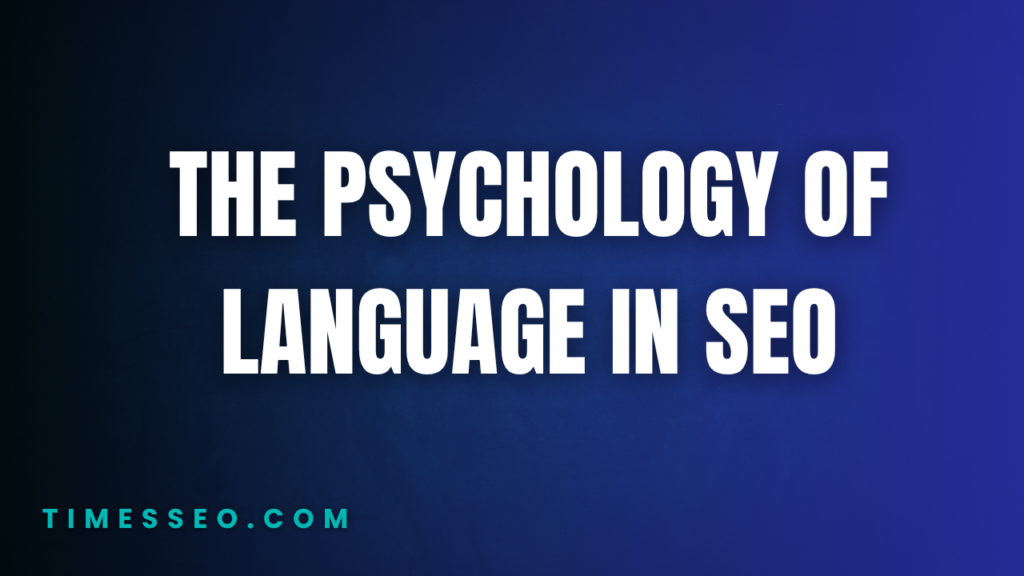
The Psychology Behind a Perfect SEO Content Checklist
“The Psychology Behind a Perfect SEO Content Checklist” explores how human behavior, emotions, and cognitive patterns influence content creation and optimization. This insightful guide reveals how to craft an effective SEO content checklist by applying psychological principles that enhance user experience, engagement, and search performance.
Table of Contents
Introduction
Have you ever noticed how some content strategies work effortlessly while others completely miss the mark? It’s not just about keywords—it’s about psychology. Behind every successful SEO content checklist is a deeper understanding of how the human brain works. Why? Because you’re not just optimizing for Google—you’re optimizing for real people with real thoughts, emotions, and behaviors.
A great checklist doesn’t just organize your SEO tasks—it speaks to the brain’s craving for structure, clarity, and reward. Let’s explore how psychology shapes the ultimate SEO content checklist and how you can use this knowledge to your advantage.
Understanding User Intent
The Core of SEO Psychology
If you’re not solving a problem or answering a question, your content is just noise. At the heart of SEO lies user intent—what someone is really looking for when they type in a search.
Navigating Informational, Navigational, and Transactional Queries
Different intents = different emotions. Someone searching for “how to fix a leaky tap” needs a guide, not a product pitch. Understanding these categories helps align your content emotionally and functionally.
Cognitive Load and SEO Content
What Is Cognitive Load?
Cognitive load refers to the amount of mental effort needed to understand information. The more demanding it is, the harder it becomes to remember and take action on it.
Why a Checklist Reduces Decision Fatigue
A checklist simplifies thinking. Instead of wondering “What’s next?”, you just follow the next step. This reduces mental friction and improves productivity.
Scannability and Chunking Content
People don’t read—they scan. Use bullet points, short paragraphs, and headers to break content into bite-sized pieces the brain can handle quickly.
The Need for Clarity and Order
Human Preference for Predictable Patterns
Your brain is wired to love patterns. Predictable formats like a checklist lower anxiety and boost comprehension.
SEO Checklists as Cognitive Anchors
When you use a checklist, you’re anchoring SEO tasks into a clear process. This makes it easier to onboard new team members and scale efforts.
How Structure Influences Trust
Clear structure = perceived expertise. If your content looks organized, users subconsciously trust that you know what you’re doing.
Emotions and Engagement in Content Strategy
Emotional Marketing Meets SEO
SEO isn’t just technical—it’s emotional. People remember how your content made them feel, not just what they read.
Using Tone, Storytelling, and Visuals to Increase Retention
Incorporate metaphors, storytelling, and familiar examples to make your content feel more personal and engaging. Sprinkle in engaging visuals that reinforce emotion, not just break text.
Checklist as a Motivational Tool
Completing tasks feels good. That dopamine rush from checking a box? That’s real—and powerful for productivity.
Authority and Confidence Through Completion
Psychological Impact of Ticking Off SEO Tasks
Each check on a list reinforces a sense of progress. This strengthens your trust in your SEO approach and motivates you to continue moving forward.
How Checklists Foster Accountability and Momentum
Checklists keep you on track. They also help hold teams accountable, which is essential for long-term SEO success.
Behavioral Psychology in UX and SEO
Habit Loops and User Journey Optimization
Create a seamless flow between awareness, interest, and action. Lead users through each step in a smooth, repeatable flow—just like how habit loops work.
The Role of Micro-Interactions in Perceived Usability
Hover effects, animations, scroll cues—these small touches make users feel in control, improving satisfaction and retention.
The Psychology of Language in SEO
Register Procedure
Power Words and Emotional Hooks
Words like “proven,” “secret,” “instant,” or “free” tap into emotion. Use them wisely in titles, meta descriptions, and CTAs.
Clarity vs Complexity in Keyword Selection
Ditch jargon. Use keywords your audience actually searches for. Simplicity wins.
Writing for Both Humans and Search Bots
Balance is key. Use structured headings and natural language so both Google and humans can understand your message.
Visual Hierarchy and Information Architecture
F-Pattern Scanning and SEO Design
People scan pages in an “F” shape. Put your most important info in that visual path—left side and top of the page.
Headings, Whitespace, and Typography Psychology
Big, bold headings draw attention. Ample spacing helps the brain process content without fatigue.
The Role of Consistency in Content Strategy
Mental Models and Content Predictability
People expect websites to behave in certain ways. Stick to familiar patterns to improve UX and reduce bounce rates.
Creating a Consistent SEO Workflow
Utilize reliable templates and frameworks that your team can consistently depend on. This reduces errors and speeds up production.
Reinforcement and Learning Loops
How Repeating SEO Tasks Reinforces Learning
Repetition wires the brain. The more often you perform SEO tasks, the more instinctive they become.
Iteration as Psychological Growth
Each content refresh or audit reinforces the learning loop. SEO becomes less of a task and more of a habit.
The Checklist Effect: Motivation and Momentum
Dopamine Hit from Task Completion
Every time you check something off, your brain rewards you with a shot of dopamine. That little reward keeps you coming back for more.
Building SEO Habits Through Consistency
A well-structured SEO checklist not only improves your rankings—it turns you into a consistent performer.
Creating a Psychologically Optimized SEO Checklist
Prioritizing Tasks Based on Mental Effort
Tackle high-impact, low-effort tasks first. Hold off on the mentally demanding tasks until later in the day.
Keeping Checklists User-Focused and Goal-Oriented
Every item should answer: “How does this help the user or the search engine?”
Practical Example: A Psychologically-Tuned SEO Checklist
Here’s a quick, psychology-based 10-step SEO checklist:
- Define the user intent clearly
- Choose emotionally relevant keywords
- Write a compelling title using power words
- Structure content with H1-H4 headings
- Break paragraphs into digestible chunks
- Add internal and external links
- Optimize images and alt text
- Use storytelling to boost engagement
- Implement schema for rich results
- Review and update older content regularly
Conclusion
The perfect SEO content checklist isn’t just about ticking boxes—it’s about understanding how people think, feel, and behave. When you apply psychology to your SEO strategy, your content becomes more than searchable—it becomes unforgettable. So, the next time you’re building an SEO checklist, think beyond keywords. Think human.
Frequently Asked Questions
Because understanding how people process information leads to better content structure, engagement, and conversion.
It removes the mental effort of figuring out what to do next, keeping you focused and efficient.
Yes! Content that resonates emotionally increases dwell time, shares, and conversions—all key SEO factors.
Keep it clear, structured, goal-oriented, and aligned with how users think and search.
Well-organized, visually appealing content improves user experience, which leads to lower bounce rates and better rankings.
Table of Contents
Popular Posts
-
 Affordable Technical SEO Audit for Small Business: A Complete Guide26 Jun 2025 Blog
Affordable Technical SEO Audit for Small Business: A Complete Guide26 Jun 2025 Blog -
 How to Get an Affordable Technical SEO Audit for Small Business27 Jun 2025 Blog
How to Get an Affordable Technical SEO Audit for Small Business27 Jun 2025 Blog -
 The Ultimate Local SEO Audit Checklist for Startups28 Jun 2025 Blog
The Ultimate Local SEO Audit Checklist for Startups28 Jun 2025 Blog -
 Local SEO Audit Checklist for Startups: A Beginner’s Guide28 Jun 2025 Blog
Local SEO Audit Checklist for Startups: A Beginner’s Guide28 Jun 2025 Blog -
 Top On-Page SEO Audit Steps for Service Websites Every Business Should Know29 Jun 2025 Blog
Top On-Page SEO Audit Steps for Service Websites Every Business Should Know29 Jun 2025 Blog -
 Technical SEO for WordPress: The Ultimate Beginner’s Guide01 Jul 2025 Blog
Technical SEO for WordPress: The Ultimate Beginner’s Guide01 Jul 2025 Blog -
 The Impact of On-Page SEO Audit Steps for Service Websites on UX01 Jul 2025 Blog
The Impact of On-Page SEO Audit Steps for Service Websites on UX01 Jul 2025 Blog -
 Technical Mobile SEO Audit Tips for Developers02 Jul 2025 Blog
Technical Mobile SEO Audit Tips for Developers02 Jul 2025 Blog -
 Complete SEO Backlink Audit Guide for Better Google Rankings03 Jul 2025 Blog
Complete SEO Backlink Audit Guide for Better Google Rankings03 Jul 2025 Blog -
 Boost Your Rankings with Technical SEO for WordPress01 Jul 2025 Blog
Boost Your Rankings with Technical SEO for WordPress01 Jul 2025 Blog






